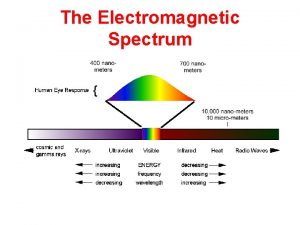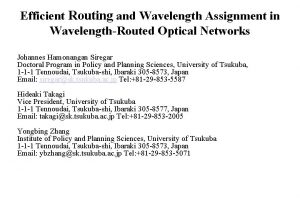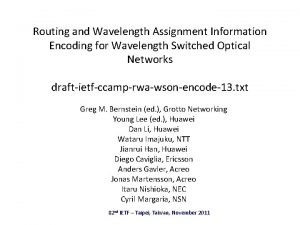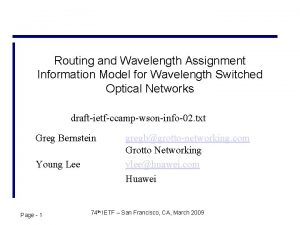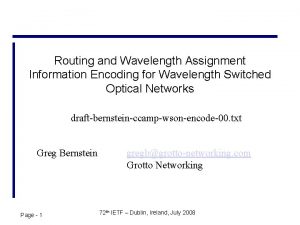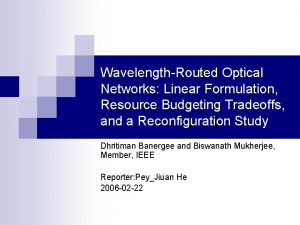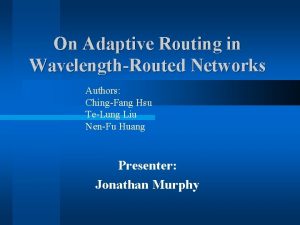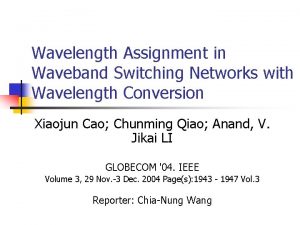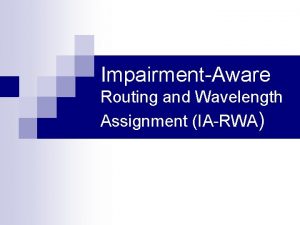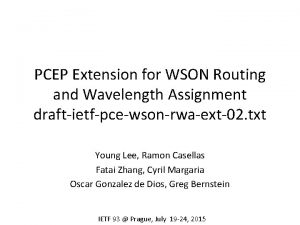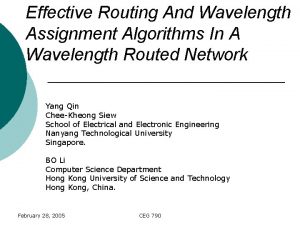Routing and Wavelength Assignment Approaches for WavelengthRouted Optical
























- Slides: 24

Routing and Wavelength Assignment Approaches for Wavelength-Routed Optical WDM Networks

Agenda • Introduction • Routing Assignment • Wavelength Assignment • Distributed Relative Capacity Loss(DRCL) • Conclusion

Introduction • Wavelength-division multiplexing(WDM) handle the ever-increasing bandwidth demands of network users • A lightpath occupies the same wavelength on all fiber links, known as wavelength-continuity constraint • Setting up a connection is routing and wavelength assignment(RWA)

Routing Assignment • Fixed routing • Fixed-alternate routing • Adaptive routing

Wavelength Assignment • Random Assignment • First-Fit • Least-Used/SPREAD • Most-Used/PACK • Min-Product • Least Loaded • MAX-SUM • Relative Capacity Loss(RCL) • Wavelength Resevation • Protecting Threshold • Distributed Relative Capacity Loss(DRCL)

Fixed Routing • Off-line calculation • Shortest-path algorithm: Dijkstra’s or Bellman-Ford algorithm • Advantage: simple • Disadvantage: high blocking probability and unable to handle fault situation

Fixed-Alternate Routing • Routing table contains an ordered list of fixed routes -e. g. shortest-path, followed by second-shortest path route, followed by third-shortest path route and so on • Alternate route doesn’t share any link(link-disjoint) • Advantage over fixed routing: -better fault tolerant -significantly lower blocking probability

Adaptive Routing • Route chosen dynamically, depending on the network state • Adaptive shortest-cost-path -Each unused link has the cost of 1 unit; used link ∞; wavelength converter link c units. • Disadvantage: extensive updating routing tables • Advantage: lower blocking probability than fixed and fixed-alternate routing • Another form: least-congested-path(LCP) • Recommended form: shortest paths first, and use LCP for breaking ties

Static Wavelength Assignment • Two lightpaths share the same physical link are assigned different wavelengths • Reduced to graph-coloring problem: 1. Construct a graph, such that each lightpath is represented by a node. There is one edge in between if two lightpaths share the same physical link. 2. Color the nodes such that no two adjacent nodes have the same colors. • Theorem: Let G be a graph with V(G)=v 1, v 2, …, v n where deg(v i) =deg(v i+1) for i= 1, …, n-1. Then minimum number of colors needed <= max 1<=i<=n min {I, 1+deg(vi)}

Random Wavelength Assignment • Randomly chosen available wavelength • Uniform probablity • No global information needed

First-Fit • First available wavelength is chosen • No global information needed -prefered in practice because of its small overhead and low complexity • Perform well in terms of blocking probability and fairness • The idea behind is to pack all of the in-use wavelengths towards lower end and continous longer paths towards higher end

Least-Used(LU) Wavelength Assignment • Least used in the network chosen first • Balance load through all the wavelength • Break the long wavelength path quickly • Worse than Random: -global information needed -additional storage and computation cost -not preferred in practice

Most-Used(MU) Assignment • Select the most-used wavelength in the network • Advantages: -outperforms FF, doing better job of packing connection into fewer wavelength -Conserving the spare capacity of less-used wavelength • Disadvantages: -overhead, storage, computation cost are similar to those in LU

Min-Product(MP) • Used in multi-fiber network • The idea is to pack wavelength into fibers, minimizing the number of fibers in the network ∏ l є π(p) D lj for each wavelength j, 1<=j<=W • Chose a set of wavelength j minimizing the above value • Disadvantage: not better that multi-fiber version of FF -introduce additional computation costs -

Least-Loaded(LL) Assignment • Multi-fiber network • Select the wavelength that the largest residual capacity in the most-loaded link along route p. • Advantage: outperforms MU and FF in terms of blocking probability

MAX-SUM Assignment • Applied to multi-fiber and single-fiber also • Before lightpath establishment, the route is pre-selected; After lightpath establishment, it attemps to maximize the remaining path capacity

MAX-SUM Assignment (continued) r(ψ, l, j) = Mj - D(ψ) lj r(ψ, l, j): link capacity, the number of fibers on which wavelength j is unused on link l r(ψ, p, j) = min r(ψ, l, j) l є π(p) r(ψ, p, j): the number of fibers on which wavelength j is available on the most-congested like along the path p

MAX-SUM Assignment(continued) w R(ψ, p) = Σ min j=1 l є π(p) r(ψ, l, j) At last, chose the wavelength j that maximizes the quantity: Σ pєPR(ψ’(j) , p) ψ’(j) be the next state of the network if j is assigned P is all the potential paths for the connection

Relative Capacity Loss(RCL) Assignment • Chose wavelength j to minimize the relative capacity loss: Σ pєP(r(ψ, p, j) - r(ψ’(j), p, j))/ r(ψ, p, j) • Sometimes better than MAX-SUM -MAX-SUM could cause blocking • Longer lightpaths have a higher block probability than shorter ones • Some schemes to protect longer paths: Wavelength reservation(Rsv) and protesting threshold(Thr)

Distributed Relative Capacity Loss(DRCL) • Using Bellman-Ford algorithm to exchange information between nodes • Routing table as well as RCL table to be exchanged • Calculate the rcl(w, d) value for all the paths from the source node to every other node, excluding the destination node • Choose the wavelength that minimizes the sum of rcl(w, d) over all possible destinations d

Distributed Relative Capacity Loss(DRCL) (continue) Calculating the value rcl(w, d) at node s: • If there is no path from node s to node d on wavelength, then rcl(w, d) =0; otherwise, • If there is a direct link from s to d, and path from s to d on wavelength w is routed though this link, rcl(w, d) = 1/k, k is the number of available wavelength; otherwise, • rcl(w, d) = max(1/k, rcl(w, d) at node n), n is the second node from s to d

Calculation in DRCL (example) Path p 1: (2, 4) Wavelength is used

Calculation in DRCL (example) (continue) wavelength (2, 0) (2, 1) (2, 3) (2, 5) (2, 6) The total capacity loss on each wavelength λ 3 λ 2 λ 1 λ 0 0 1 1/3 0 1/3 1/4 1/4 1/3 1/3 0 11/12 17/12 13/12 19/12 λ 3 is chosen 0 1/2 0

Conclusion • Adaptive routing has lower blocking probability in routing assignment • Max-Sum and RCL provide lower blocking probability in wavelength assignment, but rely on fixed routing • DRCL based on both RCL and adaptive routing, having better performance • Routing algorithm play a significant role
 What is the shortest electromagnetic wavelength
What is the shortest electromagnetic wavelength Level pool routing
Level pool routing Mark tinka
Mark tinka Hydrologic continuity equation
Hydrologic continuity equation Difference between clock routing and power routing
Difference between clock routing and power routing Amplitude wavelength and frequency
Amplitude wavelength and frequency Rhythmic disturbance that carries energy
Rhythmic disturbance that carries energy Copper chloride fire
Copper chloride fire Lambda formula
Lambda formula Frequency
Frequency Kontinuitetshantering
Kontinuitetshantering Typiska drag för en novell
Typiska drag för en novell Nationell inriktning för artificiell intelligens
Nationell inriktning för artificiell intelligens Ekologiskt fotavtryck
Ekologiskt fotavtryck Varför kallas perioden 1918-1939 för mellankrigstiden
Varför kallas perioden 1918-1939 för mellankrigstiden En lathund för arbete med kontinuitetshantering
En lathund för arbete med kontinuitetshantering Underlag för särskild löneskatt på pensionskostnader
Underlag för särskild löneskatt på pensionskostnader Personlig tidbok
Personlig tidbok A gastrica
A gastrica Förklara densitet för barn
Förklara densitet för barn Datorkunskap för nybörjare
Datorkunskap för nybörjare Stig kerman
Stig kerman Hur skriver man en debattartikel
Hur skriver man en debattartikel För och nackdelar med firo
För och nackdelar med firo Nyckelkompetenser för livslångt lärande
Nyckelkompetenser för livslångt lärande
